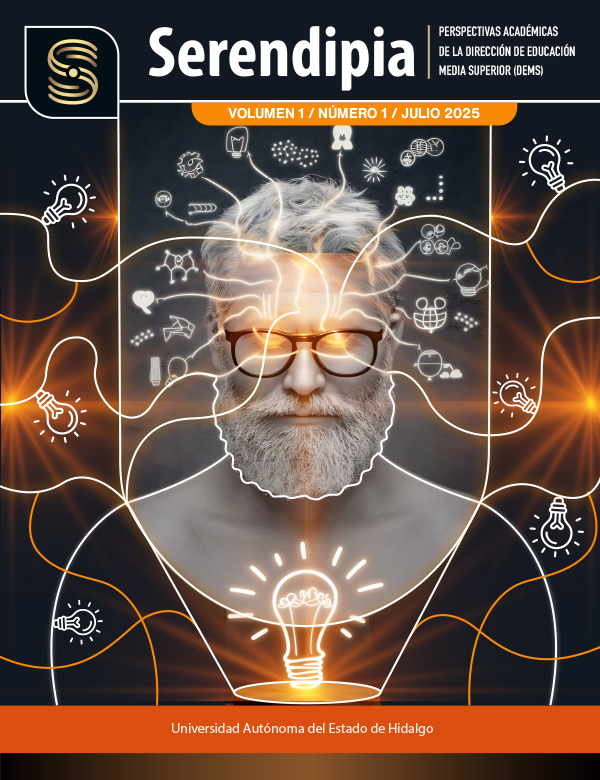El papel de Einstein en la comprensión del movimiento Browniano
Einstein's role in the understanding of Brownian motion
DOI:
https://doi.org/10.29057/serendipia.v1i1.15224Palabras clave:
Movimiento Browniano, estadística, moléculas, fenómeno, cinéticaResumen
En este artículo analizamos la importancia de la investigación de Albert Einstein en la comprensión del movimiento Browniano, este fenómeno fue descubierto en 1827 por Robert Brown, sin embargo no pudo ser explicado adecuadamente hasta 1905, año en donde Einstein haciendo uso de la física estadística explico el fenómeno al tiempo que dio una demostración de la existencia de las moléculas. Para el artículo se propone como metodología realizar un análisis de las ecuaciones del movimiento Browniano de Einstein, mismas que dieron predicciones que permitieron demostrar la teoría cinética. Los resultados exponen las pruebas experimentales que permitieron demostrar la veracidad de los resultados obtenidos por Einstein, consolidando de esta forma la teoría atómica. En la discusión abordamos las implicaciones que se tuvieron tras estos hallazgos, para finalmente reflexionar acerca de la contribución de Einstein.
Información de Publicación
Perfiles de revisores N/D
Declaraciones del autor
Indexado en
- Sociedad académica
- N/D
- Editora:
- Universidad Autónoma del Estado de Hidalgo
Citas
Duarte Bernal, J. L. (2024). Historical analysis of the origin of the Dirac equation, from its relation to the fine structure of hydrogen... pedagogica.edu.co.
Duque Escobar, G. (). Albert Einstein: On the hundred years of the theory of relativity. Department of Mathematics and Statistics. unal.edu.co
Elizalde, E. (2023). Mathematical singularities in the confines of the Universe (and a fleeting approximation to its history). csic.es
García De Castro, N. (2023). Current perspectives of indeterminism in science. eidos. scielo.org.co.
García Guerrero, M. & Díaz Marcos, J. (2021). Atoms and molecules. Nanotechnologies to change the world. 148.217.50.3
Gherab-Martin, K. (2022). Visualization of quantum objects in the Copenhagen interpretation: A historical-philosophical approach. VISUAL REVIEW. International Visual Culture Review/Revista Internacional de Cultura Visual, 9(2), 371-395. visualcompublications.es
Gordón, E. A. (2021). Difficulties in learning the concept of gas and the importance of implementing innovative strategies for its better understanding and study. up.ac.pa.
Hernández Vargas, A. (2023). Stochastic model of phenotypic evolution: An approach from game theory and stochastic calculus. uniandes.edu.co.
Herrera-Castrillo, C. J. (2024). Pedagogical practice in relativistic mechanics: approaches, strategies and their educational impact. Wani. camjol.info
Luzuriaga, J. (2022). Atoms, elements, heat: A brief history of matter, heat and temperature. [HTML]
Martínez, F. (2024). Introduction to Fluid Mechanics. researchgate.net.
Ortiz Chavarro, S. D. (2023). On Brownian motion: History, modeling and simulation. udistrital.edu.co
Peñuela Sarta, J. D. (2023). Explanation of Brownian motion: an approach to the study of microscopic systems in statistical physics.. pedagogica.edu.co.
Perez, S. A. (2023). Model for valuing decisions in the beef cattle complex: proposal of real options games. uns.edu.ar.
Perpinyà, N. (2021). Chaos, virus, calm: Chaos Theory applied to artistic, social and political disorder. [HTML].
Vargas Humire, S. & Gutierrez Valdivia, V. C. (2022). ... of Moringa Oleifera seed as a coagulant-flocculant in the process of reducing arsenic present in water for human consumption in the district of .... upt.edu.pe
Vaudo, E. (2025). Mirabilis: Five intuitions that have revolutionized our conception of the universe. [HTML]
Zecevic, A. I. (2023). Truth, beauty and limits of knowledge. [HTML]
Descargas
Publicado
Cómo citar
Número
Sección
Licencia
Derechos de autor 2025 Alfredo Olmos Hernández, Reyna Romyna Olmos Hernández

Esta obra está bajo una licencia internacional Creative Commons Atribución-NoComercial-SinDerivadas 4.0.










